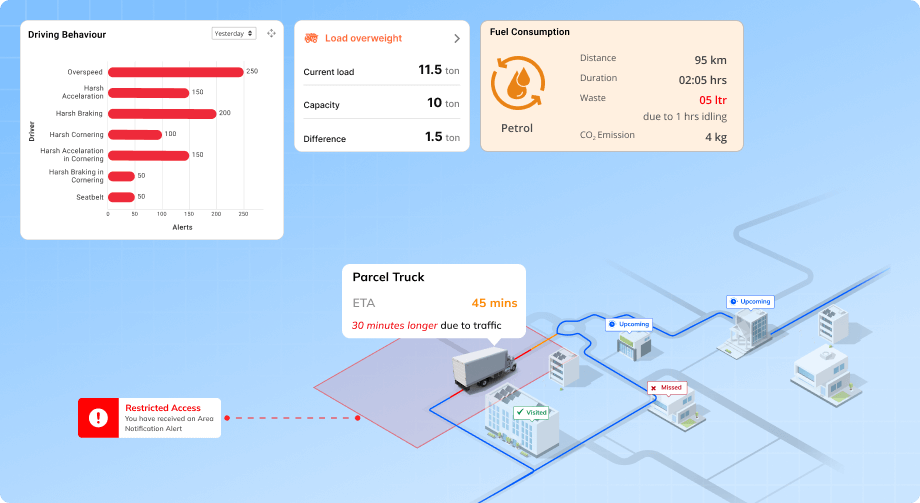The courier and parcel delivery industry is vital in ensuring that goods reach customers on time and in perfect condition. This sector deals with a large fleet of vehicles, each traveling on different routes to meet fluctuating customer demands. However, managing such a fleet can be complex due to factors like fluctuating delivery volumes, traffic disruptions, last-mile challenges, fuel costs, and driver behavior. Advanced fleet management software can solve these issues by providing real-time data, optimizing routes, and enhancing overall fleet efficiency.
Transforming Courier Operations with Advanced Fleet Management Technology
Introduction
Challenges Faced
- Fluctuating Delivery Volumes: Demand often changes, especially during peak seasons, making it challenging to allocate resources efficiently and avoid underutilizing or overloading vehicles.
- Traffic and Route Delays: Traffic congestion, road closures, and bad weather can cause significant delays, leading to inefficient routes and late deliveries.
- Last-Mile Delivery Challenges: The last-mile delivery phase is the most complex, involving navigation through narrow streets, restricted areas, and coordinating with customers for drop-offs.
- Rising Fuel Costs: Fuel is a significant cost, and without efficient route planning, fuel consumption increases, leading to higher operational expenses.
- Managing Driver Safety and Behavior: Monitoring driver behavior, ensuring adherence to safety protocols, and maintaining fuel-efficient driving can be difficult without real-time tracking and reporting.
Solutions
- Fluctuating Delivery Volumes: Fleet management software dynamically adjusts schedules and routes based on real-time demand, ensuring efficient vehicle usage during peak and off-peak times.
- Traffic and Route Delays: The software uses real-time traffic data to optimize routes, avoid congested areas, and reduce delays, ensuring timely deliveries.
- Last-Mile Delivery Challenges: Advanced software enables detailed last-mile planning, considering factors like traffic, customer availability, and restricted access, ensuring smooth final deliveries.
- Rising Fuel Costs: Fleet management software optimizes routes, reduces idling time, and tracks fuel consumption, helping lower fuel costs through better route management and improved driving habits.
- Managing Driver Safety and Behavior: The software monitors driver behavior, offering real-time feedback on unsafe driving practices (speeding, harsh braking). It promotes safer, more efficient driving, improving safety and reducing costs.
Results Achieved
- Improved Resource Utilization: Dynamic scheduling and route optimization reduced empty runs by 15-20%, improving vehicle utilization and reducing wasted resources.
- Better Customer Satisfaction: Real-time tracking and accurate delivery times led to higher customer satisfaction by providing timely, reliable service and reducing delays.
- Reduced Vehicle Downtime: Predictive maintenance features reduced unplanned downtime by 25-30%, keeping vehicles operational for longer periods and reducing repair costs.
- Cost Savings on Fuel: Route optimization and reduced idling cut fuel consumption by 10-15%, resulting in significant fuel savings.
- Increased Driver Safety and Efficiency: Monitoring driver behavior led to a 5-10% reduction in fuel consumption and fewer safety incidents, ensuring safer driving and improving fleet efficiency.
Let’s Move Forward, Together
Share your details and we’ll guide you from here.

